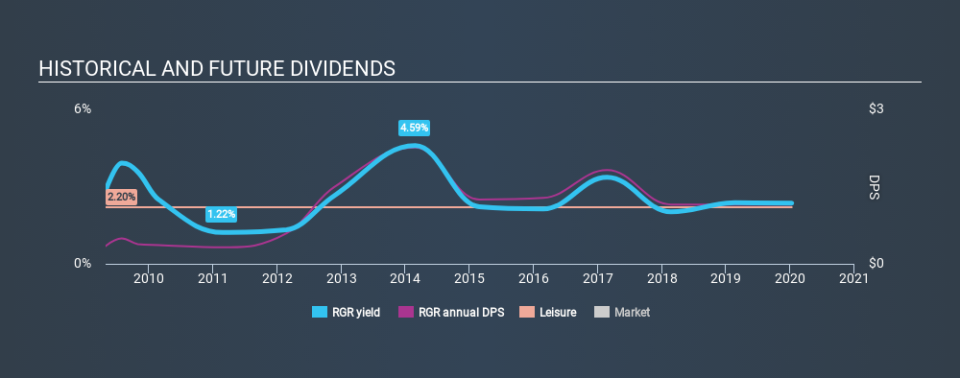Looking For Steady Income For Your Dividend Portfolio? Is Sturm, Ruger & Company, Inc. (NYSE:RGR) A Good Fit?

Dividend paying stocks like Sturm, Ruger & Company, Inc. (NYSE:RGR) tend to be popular with investors, and for good reason - some research suggests a significant amount of all stock market returns come from reinvested dividends. Unfortunately, it's common for investors to be enticed in by the seemingly attractive yield, and lose money when the company has to cut its dividend payments.
A 2.4% yield is nothing to get excited about, but investors probably think the long payment history suggests Sturm Ruger has some staying power. Some simple analysis can reduce the risk of holding Sturm Ruger for its dividend, and we'll focus on the most important aspects below.
Explore this interactive chart for our latest analysis on Sturm Ruger!
Payout ratios
Dividends are typically paid from company earnings. If a company pays more in dividends than it earned, then the dividend might become unsustainable - hardly an ideal situation. As a result, we should always investigate whether a company can afford its dividend, measured as a percentage of a company's net income after tax. Looking at the data, we can see that 39% of Sturm Ruger's profits were paid out as dividends in the last 12 months. This is a middling range that strikes a nice balance between paying dividends to shareholders, and retaining enough earnings to invest in future growth. One of the risks is that management reinvests the retained capital poorly instead of paying a higher dividend.
In addition to comparing dividends against profits, we should inspect whether the company generated enough cash to pay its dividend. The company paid out 88% of its free cash flow as dividends last year, which is adequate, but reduces the wriggle room in the event of a downturn. It's positive to see that Sturm Ruger's dividend is covered by both profits and cash flow, since this is generally a sign that the dividend is sustainable, and a lower payout ratio usually suggests a greater margin of safety before the dividend gets cut.
While the above analysis focuses on dividends relative to a company's earnings, we do note Sturm Ruger's strong net cash position, which will let it pay larger dividends for a time, should it choose.
Remember, you can always get a snapshot of Sturm Ruger's latest financial position, by checking our visualisation of its financial health.
Dividend Volatility
Before buying a stock for its income, we want to see if the dividends have been stable in the past, and if the company has a track record of maintaining its dividend. For the purpose of this article, we only scrutinise the last decade of Sturm Ruger's dividend payments. Its dividend payments have declined on at least one occasion over the past ten years. During the past ten-year period, the first annual payment was US$0.34 in 2010, compared to US$1.15 last year. Dividends per share have grown at approximately 13% per year over this time. Sturm Ruger's dividend payments have fluctuated, so it hasn't grown 13% every year, but the CAGR is a useful rule of thumb for approximating the historical growth.
Sturm Ruger has grown distributions at a rapid rate despite cutting the dividend at least once in the past. Companies that cut once often cut again, but it might be worth considering if the business has turned a corner.
Dividend Growth Potential
With a relatively unstable dividend, it's even more important to see if earnings per share (EPS) are growing. Why take the risk of a dividend getting cut, unless there's a good chance of bigger dividends in future? Over the past five years, it looks as though Sturm Ruger's EPS have declined at around 18% a year. A sharp decline in earnings per share is not great from from a dividend perspective, as even conservative payout ratios can come under pressure if earnings fall far enough.
Conclusion
To summarise, shareholders should always check that Sturm Ruger's dividends are affordable, that its dividend payments are relatively stable, and that it has decent prospects for growing its earnings and dividend. Sturm Ruger's dividend payout ratios are within normal bounds, although we note its cash flow is not as strong as the income statement would suggest. Second, earnings per share have been in decline, and its dividend has been cut at least once in the past. Ultimately, Sturm Ruger comes up short on our dividend analysis. It's not that we think it is a bad company - just that there are likely more appealing dividend prospects out there on this analysis.
You can also discover whether shareholders are aligned with insider interests by checking our visualisation of insider shareholdings and trades in Sturm Ruger stock.
Looking for more high-yielding dividend ideas? Try our curated list of dividend stocks with a yield above 3%.
If you spot an error that warrants correction, please contact the editor at editorial-team@simplywallst.com. This article by Simply Wall St is general in nature. It does not constitute a recommendation to buy or sell any stock, and does not take account of your objectives, or your financial situation. Simply Wall St has no position in the stocks mentioned.
We aim to bring you long-term focused research analysis driven by fundamental data. Note that our analysis may not factor in the latest price-sensitive company announcements or qualitative material. Thank you for reading.

 Yahoo Finance
Yahoo Finance 
